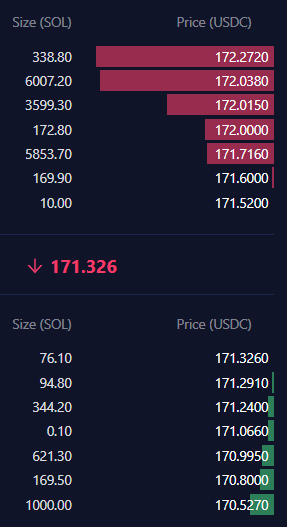Shitcoin Market Making for Fun and Profit
Today I want to tell you how you can make money by market making for shitcoins.
To be clear, I’m not trying to call any project bad by calling its token a shitcoin. What matters for our purposes here is not the quality of the project but that it has poor liquidity. In particular, we want token pairs with extremely wide spreads.
Professional market makers tend to provide liquidity for markets where spreads are small. For example, the spread for SOL/USDC is currently 171.52-171.326=0.194 USDC, or 0.11% of the current price. In other words, if a market maker had a sell order for 1 SOL at 171.52 and a buy order for 1 SOL at 171.326 and both orders are filled, they would have made 0.194 USDC, which is a measly 0.0006% of the capital required for this trade.
While the profits per trade are tiny, because it is a liquid market, there will be a lot of trading and therefore the profits build up. However, market makers are only able to do this because they automate the choosing of the price and sizing of their orders and frequently shift them according to the prices of assets on other exchanges. This is to have a better idea of the “true” price of assets and avoid selling to low or buying too high.
But most of us aren’t capable programming our own market making bots. We can, however, make a profit in illiquid markets that professional market makers are unwilling to touch.
Let’s look at Shoebill Coin (SHBL) as an example. Its current bid is 0.00008 and its current ask is 0.00015, so its spread is 0.00007 or 61% of the current price. This is orders of magnitude greater than the 0.11% we saw with SOL!
If we sell 10,000 SHBL at 0.00015 USDC and buy 10,000 at 0.00008 USDC, we will have made 7 USDC, which is 30% of the capital required for this trade. This is 50,000x greater than the profit per trade in the case of SOL!
To summarize, the large spreads mean that you need much fewer trades to make as much profit as you would in more liquid markets. Because prices change much less frequently and there are fewer people placing orders, you won’t need to shift your orders to the top of the book much either, so this can be done manually without too much effort. In extreme cases, for example when tokens such as FAB and LIQ traded at 0.01/0.02 and is almost the case with SHBL, you can double your stack in just two trades (buy at 0.01 and sell at 0.02)!
No discussion of market making would be complete without covering the risks. Market making implies holding both assets so you can both buy and sell. Therefore, similar to when you LP on an AMM, you can become subject to impermanent loss. For example, if the project rugs and takes out all the liquidity on the buy side, you will be left holding a bag of their tokens. On the other hand, if the token does a 10x, you will be left with some USDC, but you would have been much better off just holding the token. Therefore, this market making strategy works best when there is little volatility and the token trades within a range.
Personally, I like to use a regret minimization framework where, after doubling my stack, I’ll set aside half of it for hodling and continue to use the other half to market make. This way, if the token pumps I’ll still have the original amount I held, and whatever extra USDC I have from market making is just icing on top. If the project rugs, I usually only start with airdropped tokens anyways, so I haven’t lost any money (although I will have wasted time).
Happy market making!
If you would like to share your writing with the Solana community through our platform, please contact us via DM on Twitter at @TheSolanaUpdate.
This content should not be construed as financial advice. Always do your own research before investing in crypto assets and using DeFi protocols.
Follow @TheSolanaUpdate or subscribe to this newsletter to never miss an update.





